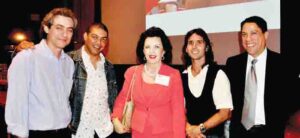 CIA brings 5 Cuban artists to Cleveland,
CIA brings 5 Cuban artists to Cleveland,
originally published October 21, 2011; page 8 Cleveland Edition
By Arooj Ashraf
Cleveland Institute of Art (CIA) is shifting perceptions of Cuban art and culture by hosting five distinguished contemporary Cuban artists for 8-week teaching residencies. Artists will teach classes and create work in Cleveland, and exhibit their work at Museum of Contemporary Art.
The Cuban Project launched for the Fall 2011 session on Oct. 13, 2011a reception and lecture meet and greet with artists Alejandro Aguilera and Osmeivy Ortega.
“Our hope at Cleveland Institute of Art is the Cuba project will enlighten our students on a cross cultural experience of not just Cuba but the world,” said Saul Ostrow, Chair of Visual Arts and Technologies Environment.
He said the Cuban Project evolved from its original goal to find a single artist who will provide CIA students an inside perspective on the influence of culture and politics on Cuban art. Forty-four artists were interviewed and the selection committee realized the divergence of approach between artists from different generations shaped art in Cuba. The project shifted its focus to inviting more artists for shorter residencies throughout the year.
Ostrow said funding and support from Cleveland Foundation’s Creative Fusion Initiative made the project possible.
David C. Hart, Associate Professor of Art History at CIA said the artists will help shape understanding and dispel common myth about the island and broaden the view most American’s hold. He encourages students and audience to engage in critical discourse and challenge all notions. Hart said the international appreciation of Cuban artists is unique to the island, “Not many artists have a bus load of tourists coming in to view their art.”
The five artists participating in the exchange program present contemporary critique of Cuban society. Ortega, a printmaker uses common materials to express message of his prints. He is excited to explore what Cleveland has to offer. He spent time in Sweden as an exchange artist and said culture reflected in his art through the expensive materials he used in his prints. “No one would make eye contact with me,” he explained his desire was to engage the Swedes, who preferred to isolate themselves with cell phones and other technology.
Aguilera represents a different generation of Cuban artists. He left Cuba in 1989 to escape political pressure and lives in Altanta, Ga. His work carries the essence of African religions and the undertone of racial tensions in Cuba. His father, a self-taught artist was well respected for his work, but prevented from receiving an award because he was black.
Aguilera said growing up with that discrimination propelled him to be more expressive in his sculptures. Though living in the U. S. has also opened possibility of unique collaborations. Crediting his wife’s love of shopping T.J. Maxx, he discovered the cultural collections artifacts imported from worldwide. He uses the pieces as his base and adds his creative touches; “It’s collaboration with unknown artists,” he said.
Keynote speaker Alejandro de la Fuente, professor of History and Latin American studies at Pittsburgh said racial discrimination and tensions in Cuba are not acknowledged publically. “Cubans do not talk about race and discrimination,” he said, instead it is considered a part of the distant past no longer relevant in contemporary society.
The country made a conscious effort eliminate discrimination by focusing on education and not discussing race. De la Fuente said nationalism took priority in the official identity of Cubans, but a consorted effort tried to eliminate the African cultures and religions. He said artists continued to keep the culture and traditions alive through their work but were largely ignored and depreciated.
Racial tensions surfaced as the country’s economy shifted to a tourist industry and lucrative jobs were awarded to light-skin Cubans who were the darker skinned; applicants were told, “They don’t have an appealing appearance,” said de la Fuente.
“The dream of a raceless, integrated Cuba remains a dream,” he said.
The Cuba Project: Cleveland Institute of Art will remain on display at MOCA till Dec. 31, 2011. In the Arooj Ashraf photo are: Alejandro de la Fuente, Alejandro Aguilera, Dr. María Pujana of Cleveland, Osmeiva Ortega, and David Hart.
ON THE INTERNET: https://www.cia.edu/
https://saltfineart.com/osmeivy-ortega/
https://www.cubanartresources.org/alejandroaguilera
https://aaas.fas.harvard.edu/people/alejandro-de-la-fuente

